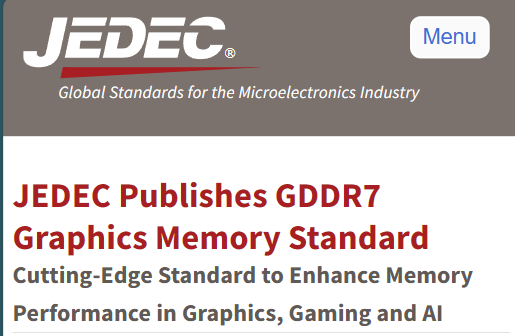GDDR7 video memory standard officially released: bandwidth doubled, AMD and Nvidia both announced full support
JESD239 GDDR7 has twice the bandwidth of GDDR6, up to 192 GB/s per device. The PAM3 interface is one of the highlights of JESD239 GDDR7. It transmits three bits in two cycles by using three levels (+1, 0, -1), compared to the traditional NRZ (non-return to zero) interface in two cycles. By transmitting two bits per cycle, PAM3 provides a higher data transfer rate per cycle, resulting in significant performance improvements and improved signal-to-noise ratio (SNR) and energy efficiency.
In addition, JESD239 GDDR7 introduces several advanced features, including:
Core-independent LFSR (Linear Feedback Shift Register) training mode with eye masking and error counters improves training accuracy and efficiency;
The number of independent channels has doubled from 2 in GDDR6 to 4 in GDDR7;
Supports densities from 16 Gbit to 32 Gbit, including 2-lane mode to double system capacity;
Latest data integrity features such as on-chip ECC (ODECC), data poisoning, error checking and cleaning, and command address parity checking (CAPARBLK).
Mian Quddus, Chairman of the JEDEC Board of Directors, said: "JESD239 GDDR7 marks a major advancement in high-speed graphics memory design. The transition to PAM3 signals provides a new development path for the graphics memory industry and promotes the continuous development of graphics and various high-performance applications."
Michael Litt, chairman of the JEDEC GDDR Subcommittee, said: "GDDR7 not only focuses on bandwidth, but also addresses RAS market needs by integrating the latest data integrity features, enabling GDDR devices to better serve existing markets such as cloud gaming, computing, and expand to AI ."
It was learned from the announcement that industry giants such as AMD, Micron, Nvidia, Samsung, and SK Hynix have expressed support for the standard. Samsung and Micron have formulated development plans for the next generation of GDDR7 modules. Samsung aims to reach 32 Gbps speeds and achieve a 1.6x performance improvement; while Micron plans to launch 24 Gb+ 32 Gbps chips. Micron also said that by 2026, it will launch video memory chips up to 36 Gbps and 24Gb+.


